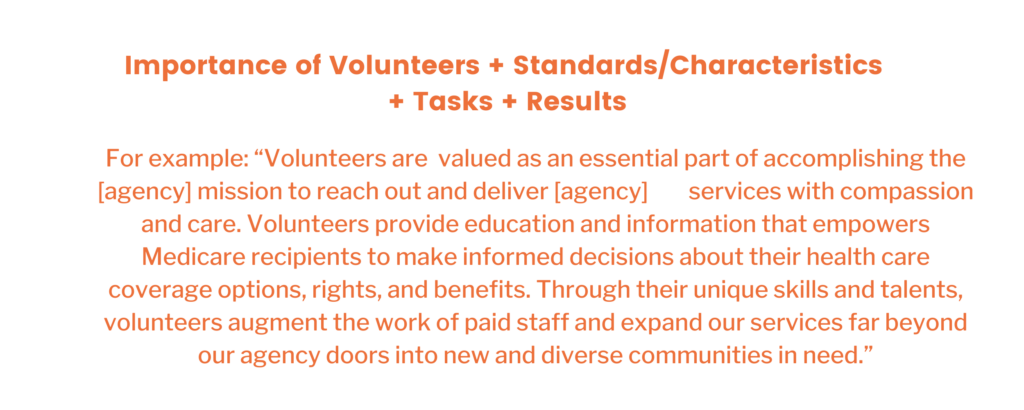
Creating a Volunteer Handbook? Here’s What to Include
It’s amazing to me how many volunteer programs don’t have a volunteer handbook. Many more don’t have a standard onboarding process. Volunteers need a GPS to help guide them through the orientation process and get familiar with their new environment. With this volunteer handbook sample of contents, you can create a guide that can act as your program’s personal GPS.
If you aren’t helping people make a smooth transition, you are risking the possibility that they will drop out early. Worse yet, without clear information about their roles and responsibilities, new volunteers may develop unrealistic expectations about what you can offer. Managing expectations is really important in volunteer management, but even more critical during the initial phases of volunteering when new recruits are still checking you out and deciding what their level of commitment will be.
Your volunteer handbook is your organization’s GPS system, with your organization programmed as the home address. It helps your volunteers locate where they are, see where they are headed, figure out how long it will take to get there. Do your volunteers a favor — don’t ask them to wander in the wilderness.
Volunteer handbooks not only help volunteers, but they also help your organization manage risk. If in the odd chance you have trouble with a volunteer, the handbook documents that you shared the rules, roles, expectations, grievance procedures, etc. with your volunteers early in their placement with you.
Finally, what a nice way to say “Welcome; we’re glad you’re here! So, much so that we’re going to take the guesswork out of volunteering, so you can focus on why you came here in the first place — to make a difference!”
If you have been tasked with developing a volunteer handbook for your organization but don’t know where to start, read on for our top tips.
Manage Talent Through Your Volunteer Handbook
A volunteer handbook plays a role in the success of managing your volunteer talent pool. When a volunteer begins their journey with your organization, they aren’t looking for a resource that will cover key technical aspects of the job they will do. Instead, a volunteer wants to see how they fit into your organization by learning, through social clues, about “how things are done around here.” A high-quality volunteer handbook can also inspire volunteers to see what’s possible as a result of their service.
Volunteer handbooks can also help deepen levels of engagement. When volunteers start, many haven’t yet fully committed to your program and are still checking out how your organization runs. A well-written, informative, and approachable volunteer handbook answers three critical personal questions your new recruits are asking themselves- Does this organization have the capacity to make a difference in the world? Can I make a difference here? Will I fit in?
Have Fun With It and Get Creative!
Gone are the days of stuffy, bureaucracy. Write your volunteer handbook as if you were explaining how things work to a friend. Better yet, recruit volunteers to help create your handbook in their own words. Assign each person a section and include their photo and a short quote about why they volunteer at the beginning of that section.
Consider ditching the beefy, multi-paged document jammed in a 3-ring binder. Not only will you save money on printing costs, but you can post the handbook on your website where volunteers can easily find it when they need it. Or, write it as a comic book or graphic novel, with illustrations and lots of colors.
It will also allow you to get more creative with the contents. Sprinkle in volunteer and client testimonials. Include photos of volunteers in action or, take photos of clients with hand-held signs that note why they personally appreciate your volunteer team. To reinforce critical concepts, you can also create an accompanying video of volunteers sharing key points.
What to Include in Your Volunteer Handbook
Contrary to what I’ve seen a lot of out there, a volunteer handbook is not a compendium of technical information your volunteers need to know to do the job you are training them for. Rather, it is a manual that lists the policies and procedures you expect them to abide by as well as the support they can expect from you. They don’t need to be boring, either. You can include photos and inspirational quotes, and you can design it in any shape or format you’d like. Any format will work as long as the information is there and easy to access.
What else should you include?
Here is a long list of things you might include.
- A Heartfelt Welcome: Include a welcome letter from a leader (either executive management, the board chair, or a respected community leader), and use it as an opportunity to resell the benefits of volunteering for your organization, show gratitude for their commitment, and set the tone for their relationship with your organization.
- Information about Your Organization: Don’t assume your volunteers know a lot about your organization! Include a history of the organization, your mission and vision, programs & services/who you serve, organization chart, community partners, map of program sites, key funders, etc.
- Philosophy of Volunteerism: A statement that speaks to your organization’s rationale for having volunteers involved. Volunteers need to know why they are important to your operations, and this statement, when crafted the right way, shows the value and impact of volunteers! This should be one of the first few pages of your handbook. Here is our formula for developing your organization’s philosophy of volunteerism:

- Ethics Guidelines: Include your policies, procedures, and statements on diversity and inclusion, anti-racism, sexual harassment, mandated reporting, alcohol and drugs, maintaining professional boundaries, volunteer-client relationships, volunteer-paid staff relationships, client service, conflict of interest, prohibition on affiliations, accepting gifts or compensation, etc.
- Working Conditions: Much like employee handbooks, it’s important that you include information about workplace safety, especially when volunteers may encounter work that is physically and/or emotionally challenging. Include a procedure for reporting accidents and injuries, guidelines for working with contagious diseases, procedures for working off-site (if allowed), tips for emotional and physical self-care, and how to request special accommodations.
- Customer Service: If volunteers are going to have direct contact with clients, you need to ensure they have the tools, support, and knowledge to meet your organization’s service standards. You can accomplish this by including information on your organization’s anti-discrimination policy, how you work to serve limited-English and low-literacy people, information on liability protections, including the federal Volunteer Protection Act and state Good Samaritan laws, your policy on volunteer-client relationships, procedures on how to maintain client confidentiality and keep client records, etc.
- Required Paperwork and Reporting: Your organization likely has rules and regulations that you must follow when it comes to engaging volunteers in service. Ensure you outline these policies clearly, and let your volunteers know how your organization uses the information gathered. For example, if you have a grant requirement that requests monthly reports on volunteer hours, outline why it’s important you collect this data, how they submit their data, and who they should contact with any questions/concerns.
- Training: All volunteers should follow the same onboarding process, regardless of their role with the organization. Include that process in the training section of your volunteer handbook so all volunteers know what to expect. Make sure you include the responsibilities of the organization and the expectations for volunteers in the onboarding process. Also include any training modules, schedules, certifications, continuing education opportunities, and, train-the-trainer opportunities for volunteer roles that require it.
- Perks/Benefits: Volunteering is a two-way street, and no matter what motivates someone to volunteer, the expectation is that they will receive something (tangible/intangible) for their involvement. This is where you can insert some fun! Show how you recognize your volunteers, include photos and client and staff testimonials that show how much your organization loves and appreciates volunteers. Include information on how volunteers to request reimbursements, referrals/references, etc.
- Supervision and Support: Volunteers must know who to reach out to when they encounter challenges on the job or need additional support. Include information on volunteer department staff roles, a contact person for each program area, policies and procedures on attendance, time-sheets, leave of absence, resignation, dismissal, the right to progressive discipline, reasons for immediate dismissal, etc.
- Volunteer Feedback: Offering opportunities for volunteer feedback is an important part of the volunteer journey and you need to provide information in your volunteer handbook on how you will collect this information and how it will inform your volunteer engagement strategy. Provide details on how volunteers can file a grievance or complaint, how your organization collects feedback for program evaluation, and how you conduct exit interviews.
- Resources and Attachments: Finish your handbook with helpful information that makes it easy for your volunteers to connect to your organization on a bigger level. Include links to web sites, marketing materials, how to order office supplies, how to use office equipment, a contact list for key staff, marketing materials, social media profiles, etc. If your organization has social media or marketing policies concerning sharing information, make sure you include it in this section.
Short on time? Pick areas that represent a high risk for your organization or areas where volunteers frequently have questions. Don’t forget that volunteers can help determine what you do or don’t need in your volunteer handbook.
Finally, be sure to have your handbook reviewed by your human resources or legal staff. Just because volunteers aren’t paid, doesn’t mean there aren’t laws or regulations you must follow. Make sure you’re aligned with your agency’s expectations and the law.
What if I Don’t Have Time to Develop a Volunteer Handbook?
It’s time to delegate! Ask a committee of veteran volunteers or board members to help you out. It’s a relatively easy task, as long as all of the policies and procedures have been decided. If not, think about hiring a consultant to help you think through the decisions that need to be made.
What would you add to my list of Volunteer Handbook “must-haves”? Add to my list in the comments section.








Leave A Comment